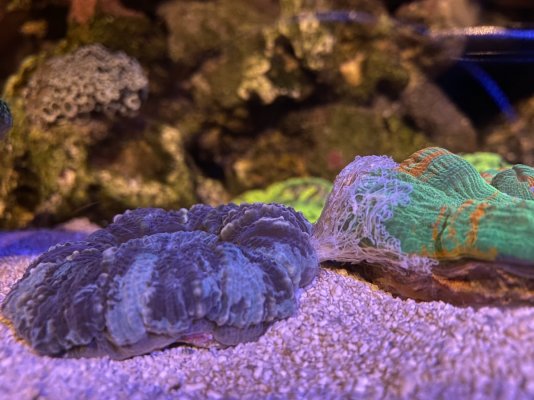Navigation
Install the app
How to install the app on iOS
Follow along with the video below to see how to install our site as a web app on your home screen.
Note: This feature may not be available in some browsers.
More options
You are using an out of date browser. It may not display this or other websites correctly.
You should upgrade or use an alternative browser.
You should upgrade or use an alternative browser.
So... I thought Scolys got along...
- Thread starter jassermd
- Start date
-
- Tags
- coral war coral warfare scolys
- Tagged users None
I tend to keep sand swept away from their bases. They most always have a lower or off center side, that said faces towards the flow so that it goes up over it rather than catching the edge of flesh and it pulling it down across its body.Any special tips on taking care of scoly’s?
Target feeding is huge! If those tentacles pop out, regardless of time of day homeboys are getting a snack of some decent quality food. MAKE SURE COMPLETELY UNFROZEN. They don’t do so well with super cool/cold foods.
Also remember to keep in mind that just like Zoas, Scoly‘s tend to have that symbiotic algae Zooxanthellae that provides most of their nutrients. In that regards they can be taken care of much like a Zoanthid in that lighting plays a key role. Consistency and attention helps as always and don’t be afraid to try a new spot. Just try and turn the flow down for a little bit so he can settle.
I should probably just stop here so that I don’t end up writing a book.
Actually just started a podcast (I’m brand new, first try so anyone reading that listens, please be kind lol ) “Gettin’ Salty Tank Talk”. The first episode comes out tomorrow at 6am and is about Zoas. I’ll have to make sure I do a deep dive about Scolymia soon.
PeterC99
Solarbenchmark.com
View Badges
Excellence Award
Reef Tank 365
NJRC Member
Hudson Valley Reef Keepers
Hospitality Award
My Tank Thread
My Aquarium Showcase
Thank you and good luck with the podcast!I tend to keep sand swept away from their bases they most always have a lower or off center side, that faces towards the flow so that it up over it rather than catching the edge of flesh and it pulling it down across its body.
Target feeding is huge! If those tentacles pop out, regardless of time of day homeboys are getting a snack of some decent quality food. MAKE SURE COMPLETELY UNFROZEN. They don’t do so well with super cool/cold foods.
Also remember to keep in mind that just like Zoas, Scoly‘s tend to have that symbiotic algae Zooxanthellae that provides most of their nutrients. In that regards they can be taken care of much like a Zoanthid in that lighting plays a key role. Consistency and attention helps as always and don’t be afraid to try a new spot. Just try and turn the flow down for a little bit so he can settle.
I should probably just stop here so that I don’t end up writing a book.
Actually just started a podcast (I’m brand new, first try so anyone reading that listens, please be kind lol ) “Gettin’ Salty Tank Talk”. The first episode comes out tomorrow at 6am and is about Zoas. I’ll have to make sure I do a deep dive about Scolymia soon.
- Joined
- Jul 4, 2018
- Messages
- 2,634
- Reaction score
- 5,369
Sucks the pretty one lost. Figures. My candy apple was too close to some bizarro
Cyphastrea that was growing on the glass and it’s crazy how it “pukes” it’s guts and just melts that stuff. It’s efficient as all get out
Cyphastrea that was growing on the glass and it’s crazy how it “pukes” it’s guts and just melts that stuff. It’s efficient as all get out
The skeleton is picked clean (thanks CUC!) and the tissue looks to be healing. It didn't get the feeders or the mouth, so I think it will survive and regrow. Time will tell...Good information. Did that green guy survive?
And yes, it sucks that the pretty one got fried!
Similar threads
- Price: 600
- Shipping Available
- Replies
- 3
- Views
- 345
- Replies
- 2
- Views
- 192
- Replies
- 0
- Views
- 114
- Replies
- 0
- Views
- 269


















